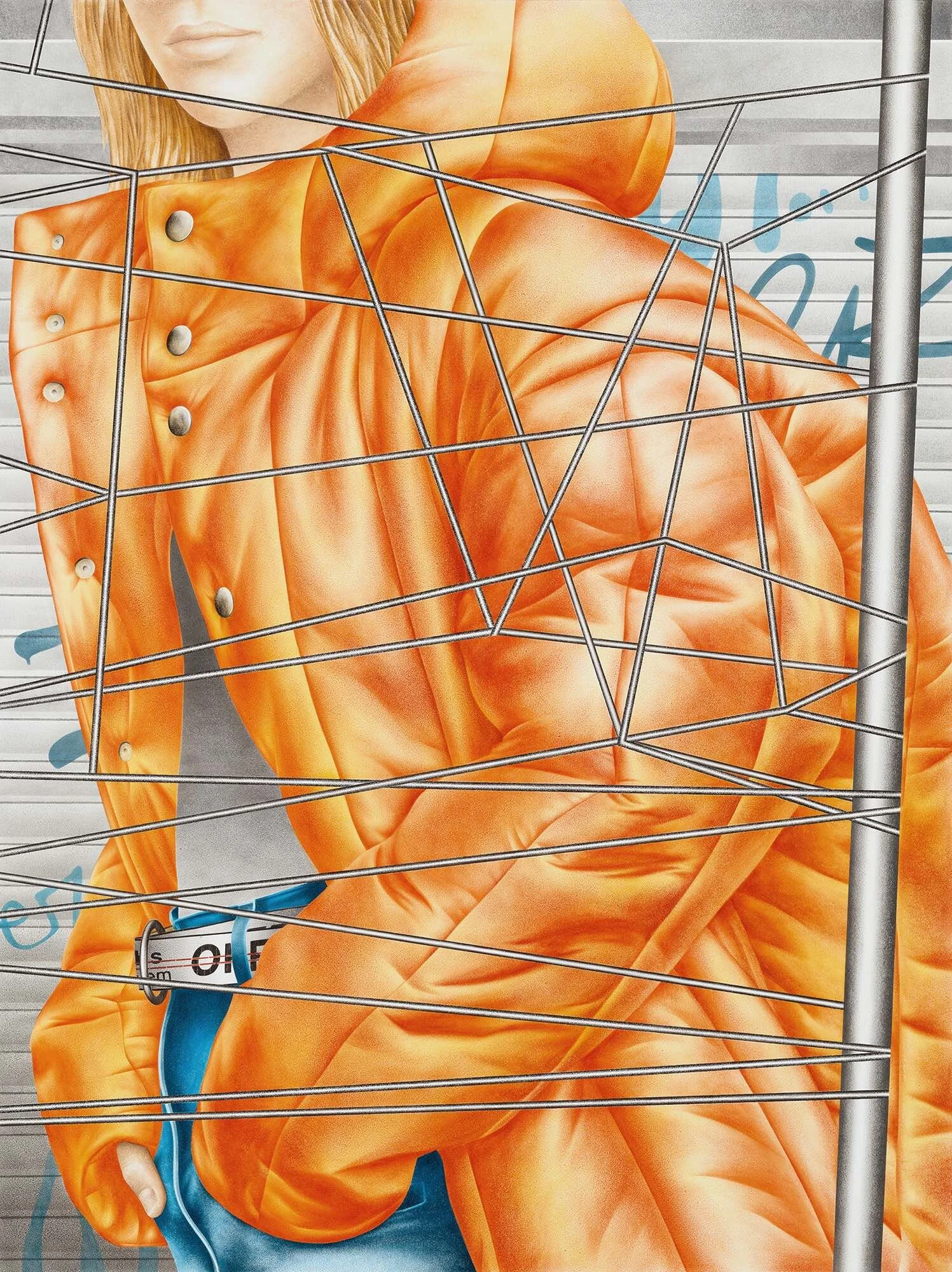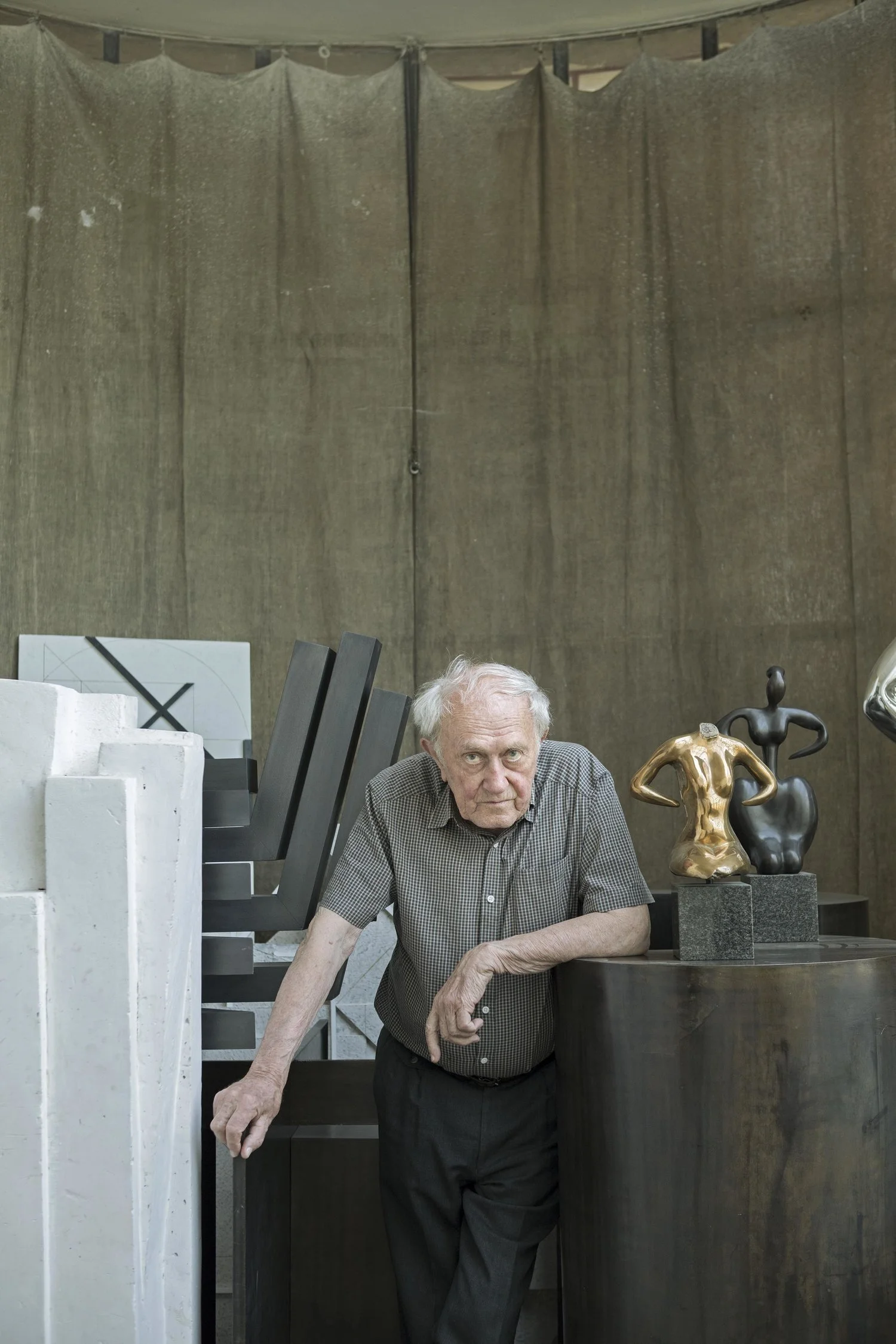Sebastian Burger On Fashion, Painting and Leipzig
Sebastian Burger, Mira (PNL/RL), Oil on Aluminium, 80 × 60 cm, 2018
Sebastian Burger attended the Hochschule für Grafik und Buchkunst in Leipzig, graduating in 2012 from the Master Class of the renowned German artist Neo Rauch, one of the foremost representatives of the New Leipzig School, which lead the revival of figurative painting in the 1990s. Burger’s own practice walks a fine line between representative and abstract painting. The starting point for his work consists of stylised imagery, often composed in a manner akin to collage, alternating precisely executed illusionism with two-dimensional representation. His work bears the influence of the legacy of surrealism and magic realism, as well as the metaphysical painting of Giorgio de Chirico, who has become a centre of interest for a strong current of the emerging generation of young artists.
This interview was conducted at the end of March 2019 on the occasion of Sebastian Burger’s exhibition Soft Gator Boy in Prague’s Berlínskej Model Gallery. The show’s guest participant is Cassidy Clingman, currently on a residency in Leipzig. This is the first exhibition presenting the artists in the Czech Republic.
Monika Čejková: In your previous series, you made references to current fashion trends, for example the streetwear brand Off-White, or the fanny pack phenomenon. Was that meant to be ironic, or was it a form of documenting a certain urban subculture, one to which you yourself belong?
Sebastian Burger: I don’t know how I feel about the term ironic in relation to my work. There may be a tiny bit of humour or playfulness at times, but I’m not so sure about irony. Irony would imply that I distance myself from what I do — which I most certainly don’t. Fashion itself seems to be very ironic at the moment, verging on caricature with brands like Vetements or Off-White. I’m not sure whether irony has a liberating force anymore. In fact, it might have become quite the opposite. I come across things left and right, but I don’t think that qualifies for documentation. they’re worth documenting. Maybe in the sense that things that I see might show up in what I do at some point. Art should always be a transformative process though. At least this is what I hope to achieve.
MČ: When did you start to be interested in using fashion in your work?
SB: I don’t consider myself a very fashionable person, I’m too slow for that. While I’m definitively interested in fashion from a distance, I approach it more as an onlooker. To incorporate it into art isn’t easy at all. In that respect I fail all the time. You have to argue with it, I think. In the past, there have been amazing people who lived on the edge of both worlds, just think of Elsa Schiaparelli or Alexander McQueen. Usually fashion people know things that artists don’t, and vice versa.
MČ: Your works occupy an uncertain terrain between adoration and disgust, everyday banality and fantastical dream space. Does our everyday experience with virtual reality and social networks play a role in this?
SB: Maybe it does. Probably. There are many things going into what I do because there are just so many things out there, too many things perhaps. The sheer abundance of opinions, contradicting facts, just stuff in general challenges reality — and truth as well for that matter.
What the observer sees and what might be looking back at him plays a big role in my recent work. I try to make paintings that draw you in with delicate textures and gradients, but at some point might almost repulse you through the harshness of shapes, forms and colours. A back and forth that interrupts your contemplation. This makes things a little more uncomfortable I guess.
“I paint on aluminium panels actually. I like their industrial, machined character. It goes well with the subjects of my paintings, I think. I do call myself a painter even though I don’t actually feel like one.”
MČ: You’re part of the young generation of artists active on Instagram. What do you think of the role of Instagram in influencing contemporary art?
SB: Instagram is great and all but, to be honest, I’m getting a little tired of it. There’s still a lot of interesting content but a lot of sameness too. There are things that look so good online but turn out to be hollow in real life. I don’t want to be hollow and I don’t want my work to be hollowed out.
MČ: Are your paintings based on photographs?
SB: They are. But it’s never just one single photograph — or only photographs. The closest I have come to that was a portrait I made of an artist friend of mine recently. Photographs and of course Photoshop are such powerful tools that you have to be aware that you’re still the one in charge and make sure they don’t take over and end up using you. There has to be a transformative quality to the process, something that you as a creature, a body, put into it — a variable, a glitch.
MČ: What kind of tools and materials do you actually use most often?
SB: Aluminium panels, a grinder, a selection of different primers, a roller to apply them, Photoshop, a printer, paper, paperweights, masking tape, erasers, a couple of brushes, very nice oil paints, more tape and aluminium profiles. That’s a complete list, more or less.
MČ: Do you consider yourself to be a painter?
SB: I paint on aluminium panels actually. I like their industrial, machined character. It goes well with the subjects of my paintings, I think. I do call myself a painter even though I don’t actually feel like one. I like the absolute perfect flatness and silky translucent texture of my works. I actually try to avoid painterly gestures and marks, but I can certainly appreciate it a lot in other people’s work. There are such good painters’ painters out there! I envy them at times.
MČ: Could you talk a bit about your studies at the Master Class of the renowned German painter and principal artist of the New Leipzig School, Neo Rauch — in retrospect, how do you see this experience with the figurative tradition that made the Leipzig School so famous?
SB: As far as I’m concerned, I think just about everybody agrees on what an incredible craftsman he is. Whether you like the subjects of his paintings or not: he is simply a remarkable painter. I’m not really a painter, so I can relax and just marvel at his enormous talent. However, the most important thing I took from my time studying with him was how to look at paintings and actually read them. He is unbelievably precise in his intuitive approach to images. I learned a lot about myself through that process actually. And his ability to spot compositional mistakes while standing in the doorway to your studio— no matter how big it might be — is rather impressive, too.
“When I started digging through my archive of what existing work we could use for the show, I came across that big buttery face peeking through a bunch of weird scaffolding.”



